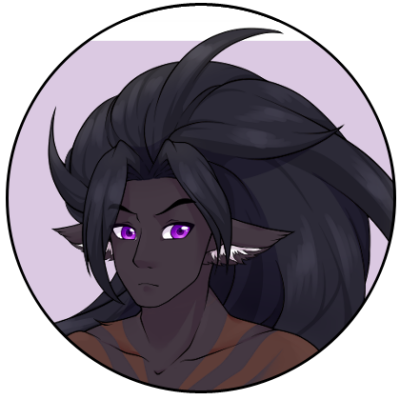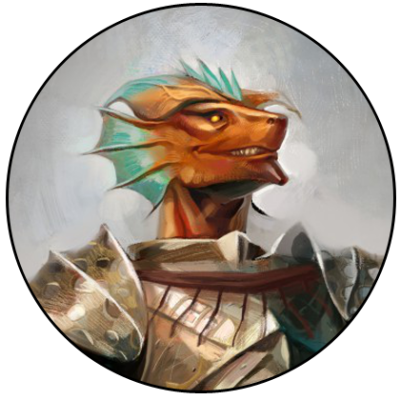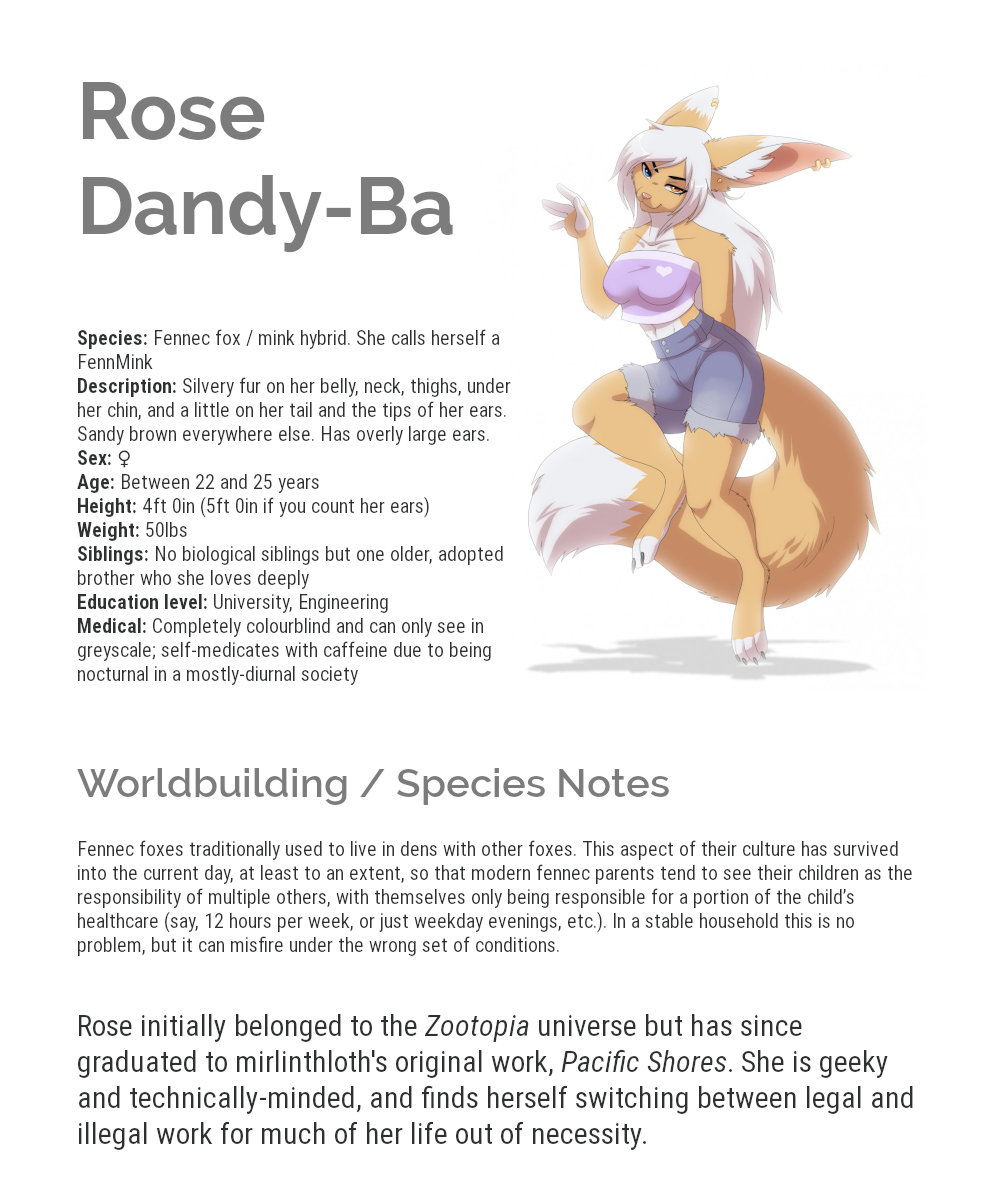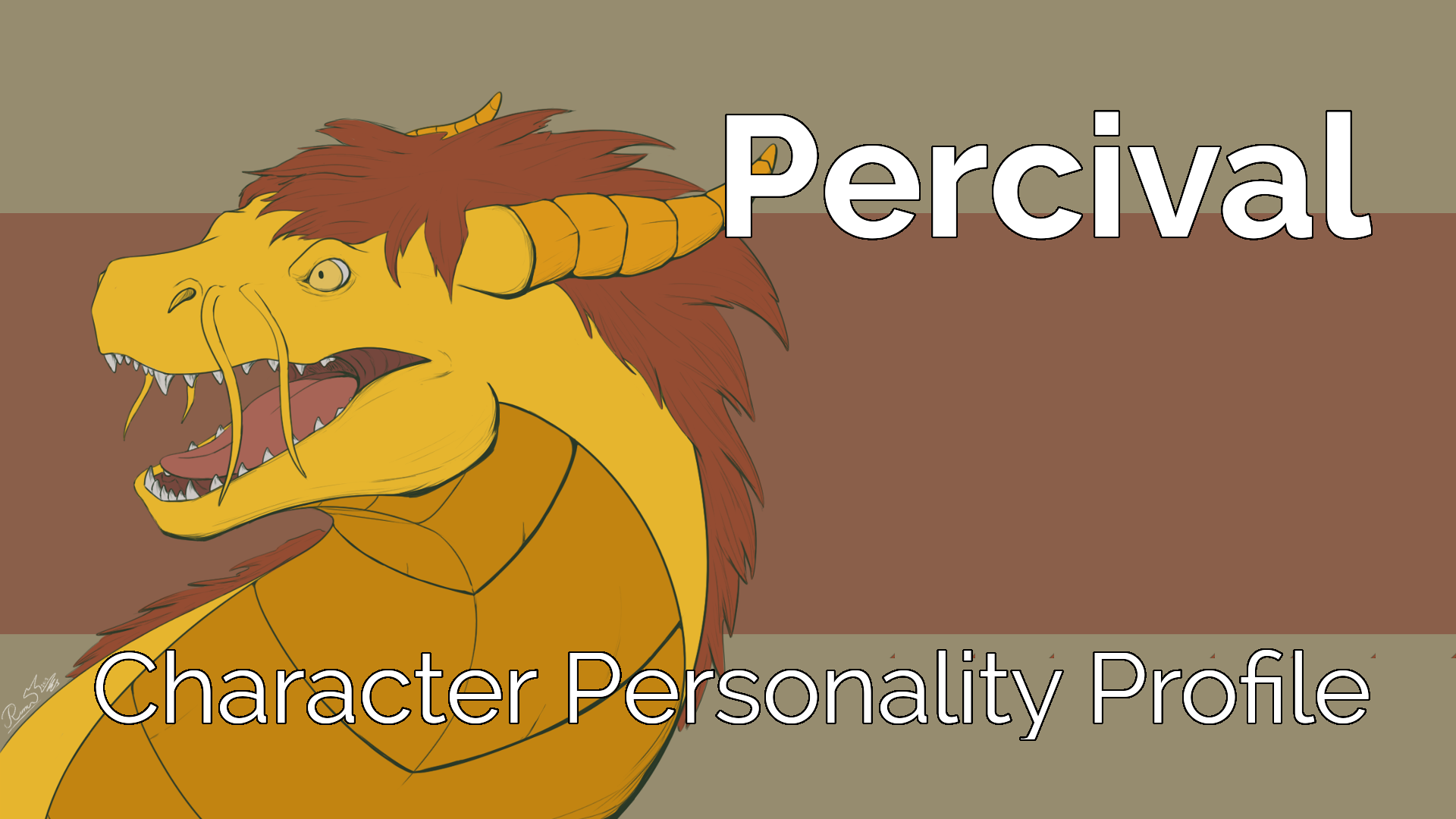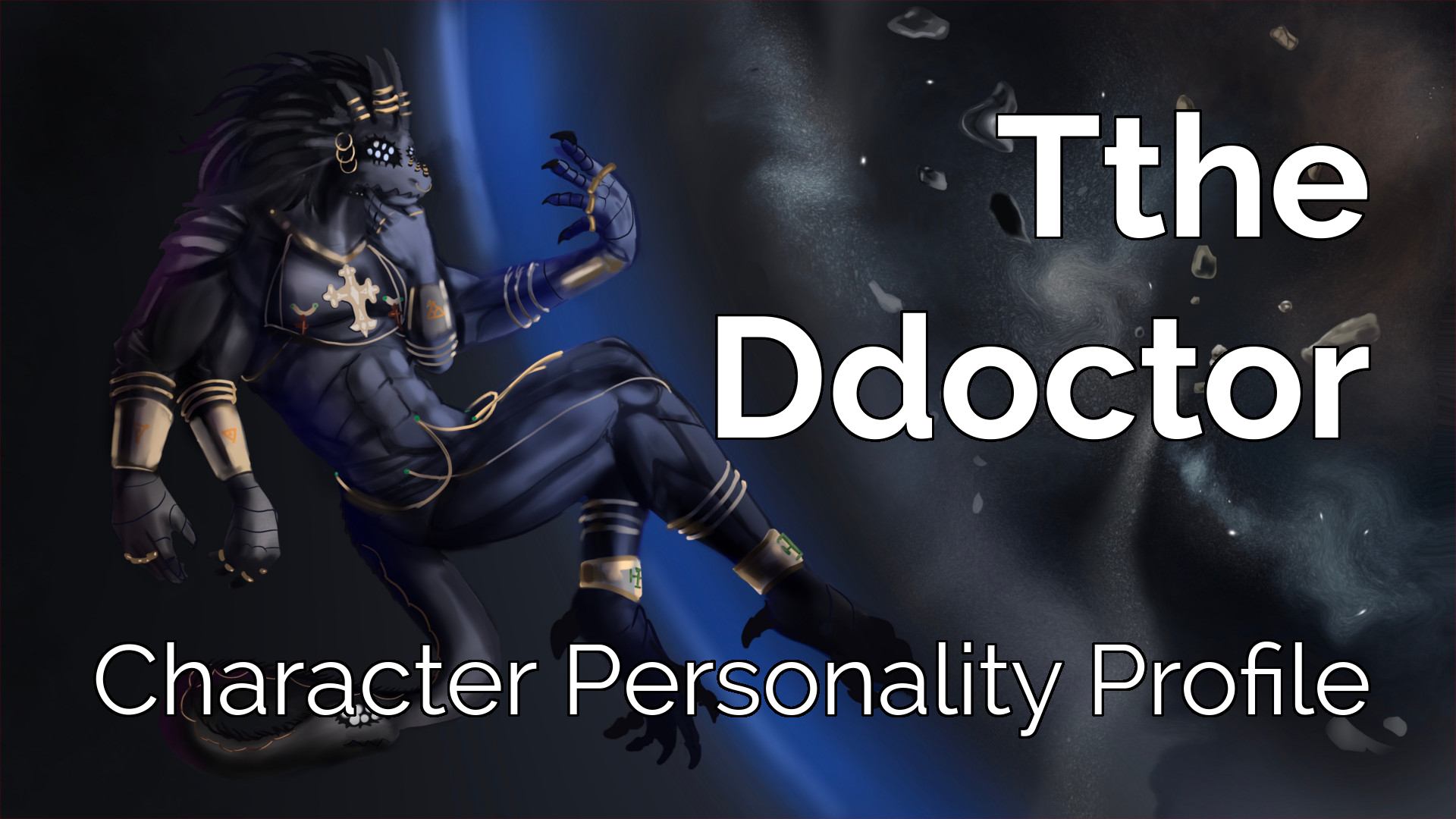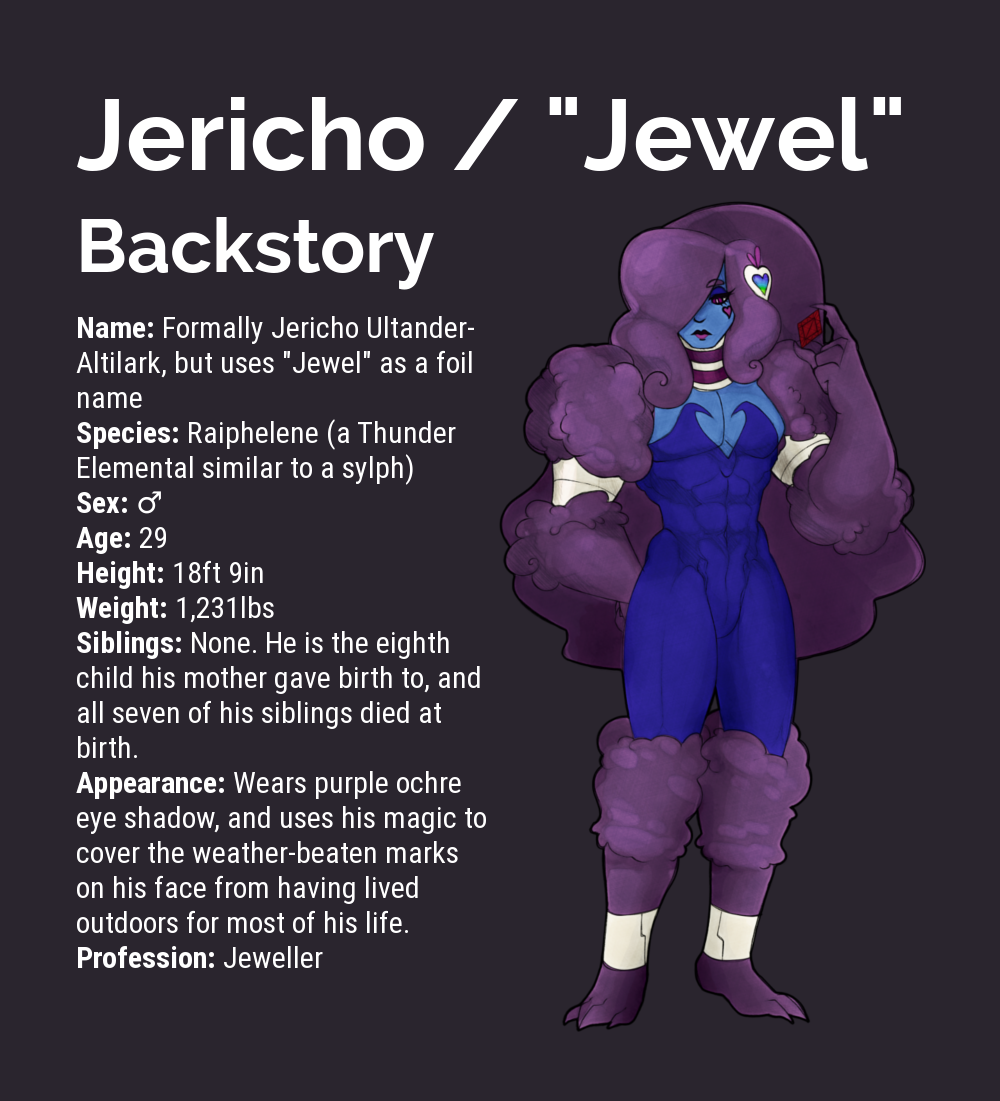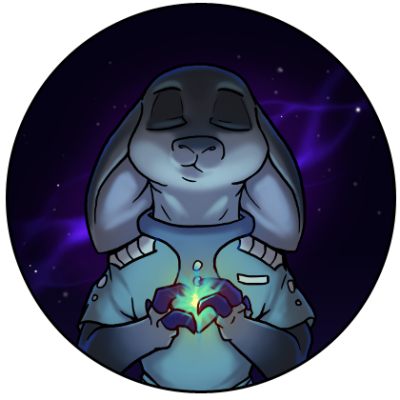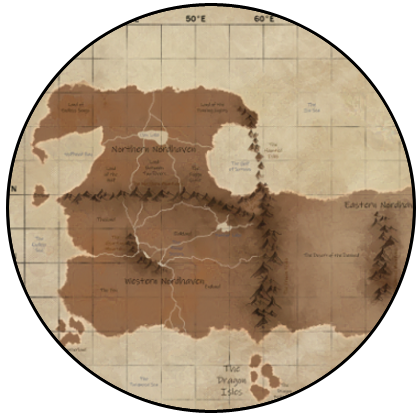How To Fill Out A TCC Questionnaire
In the world of online art commissions it's common to order a visual reference sheet, to show off the exact way you want your character to look. This is generally seen as 'the done thing' as it makes commissioning easier for artists. It means they don't have to guess what your character looks like, and can get on with creating the picture you want. I've included pictures of two visual ref sheets here.
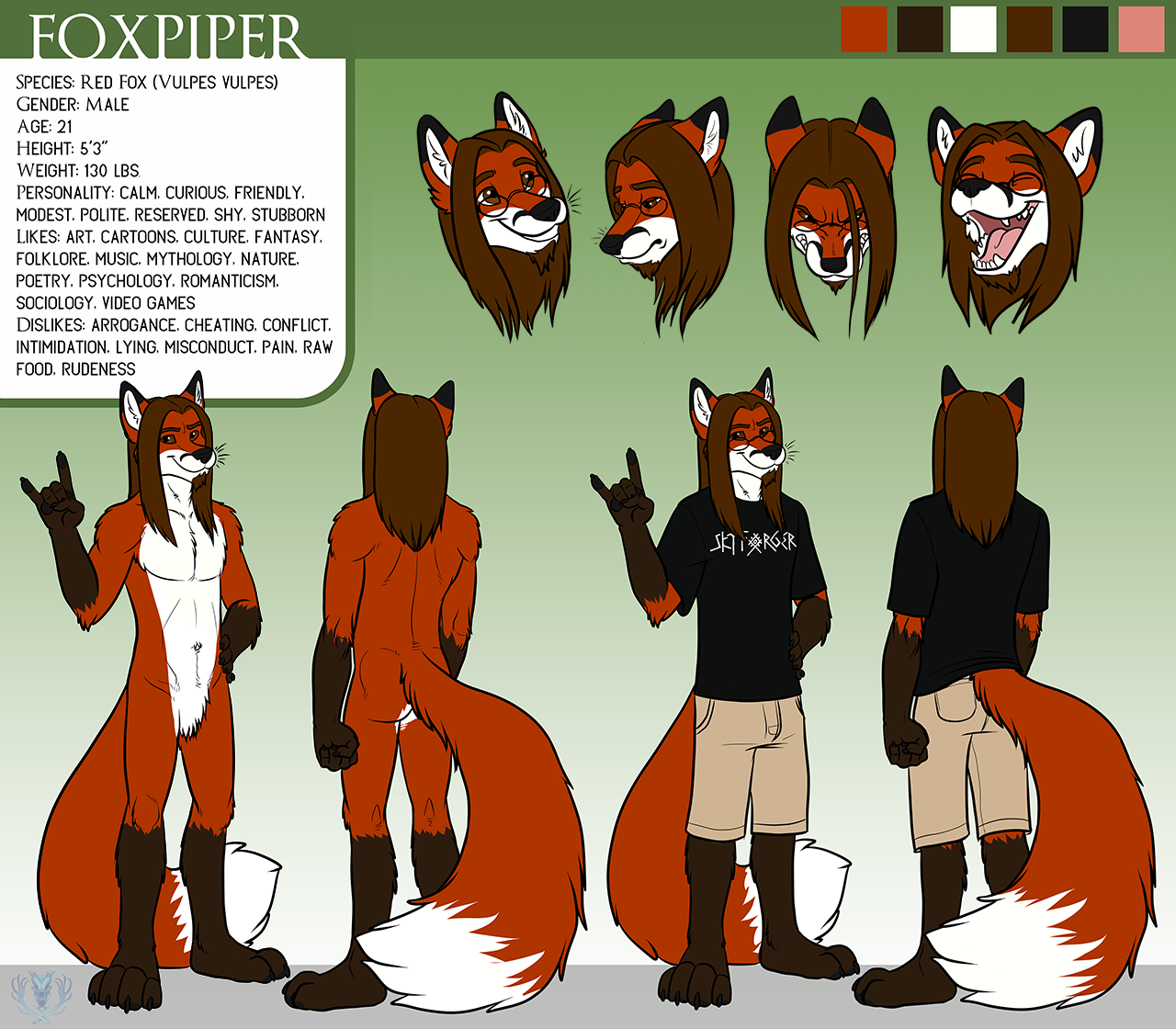
However, there's no equivalent for characters' personalities to ensure they are depicted consistently in stories, and I think that needs to change. That's what I've been doing at The Character Consultancy since I founded it in September 2018.
Ordering a psychological character profile is similar to ordering a visual reference sheet: I need information so that I can start working with you to get an end result that's psychologically realistic, that you find pleasing, and so I can create a finished document that you can show to any story writer you want to commission. To do this, I ask you to fill out a questionnaire so I know enough about your character to get started, and then write you a first draft. During the draft I ask you further questions specific to your character until I know everything I need to and have written the profile to your satisfaction.
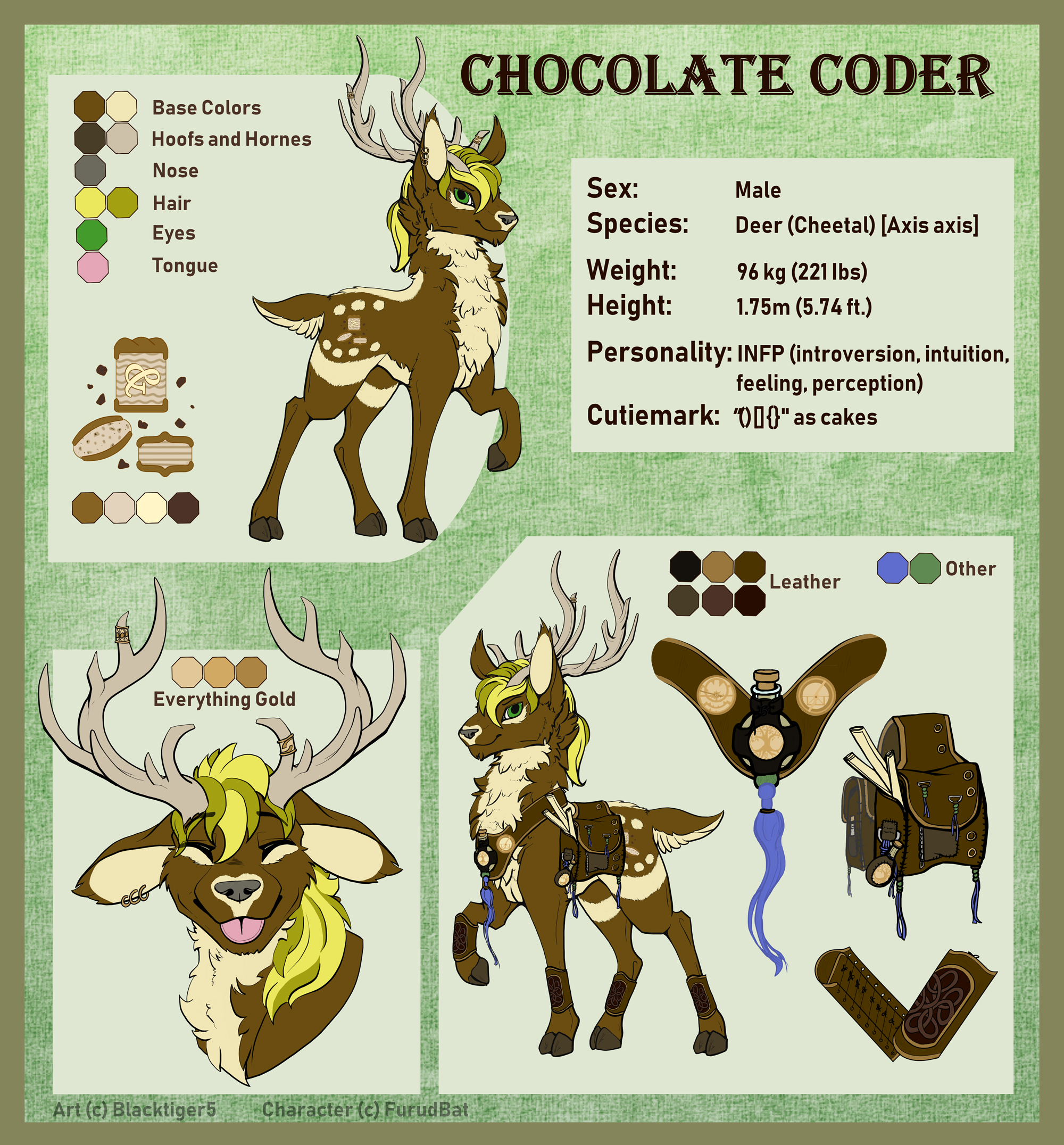
Some people tell me they feel unsure about how to fill the questionnaire properly. Before I go on I want to say that I realise that this article is very long, but don't let that put you off! There really is no right or wrong way to fill in a character profile questionnaire so you'll see a range of 'filling in' styles and quantities of details given here. It just happens that when I reached out to my clients and asked for permission to use their questionnaires, a lot of them came back!
I hope this article helps you to feel more confident about commissioning a psychological character profile!
What Does the Empty Questionnaire Look Like?
First of all, here are the most up to date versions of the questionnaires I work from: Character, Species, and Worldbuilding. The right-hand boxes contain guidance to help you fill them in.
The Character questionnaire is the most popular, so let's look at that one first. You'll notice that the stages, starting on page 2, are separated by age: newborn - 6 months, 6 months - 2 years, and so on. They're based on Erik Erikson's 8 Psychosocial Stages of Development. I've changed the stage headings to make them sound less technical, and you'll notice that the questions are all about your character's psychological development.
The questionnaire is written on the assumption that your character is going to age the same way as a regular human (or near enough to it), but I can work with characters who don't age in the same way or at all, such as AIs or spirits. There's a section about those later in this article.
So let's take a look at the questionnaires filled out by my past clients so you can see how this plays out for different characters.
Direct Answers
Questionnaires filled in with direct answers to the questions are the quickest for me to work with. This doesn't always suit my client's needs (see Long Stories below) but whenever possible, this is how I prefer to work, as it distills the information I need to work with you on your character's psychology.
Here are a few examples.
Bomberdragon wrote answers for his human-feline RPG character, Daniel "Baoh" Jones, without directly referring to the questions, but let himself be guided by them. This made Baoh quick and easy to write for and you can see the finished result in his No Frills (click the image on the right to view). TheGoldenJackal gave me similarly direct answers about his spiritual jackal, Siber, too.
9 (sometimes called 89) is a giant wasp created in a laboratory, and an example of a character who aged differently to humans, which made filling his questionnaire in potentially more of a challenge for KaiseReich, 9's creator. KaiseReich answered as many of the questions as he could. He wasn't sure how to answer them all, but the answers he did give, he gave clearly and concisely. This gave me enough information to be able to give KaiseReich guidance on the unfilled-in segments, and we completed a No Frills for 9.
Also notice the addendum at the end of 9's questionnaire. Often people give me extra information like this, and the way he did it here is just fine.
Kiroku commissioned me to work on his Dungeons & Dragons character, Devorak. This questionnaire is unformatted as Kiroku worked from a device that didn't support my questionnaires in the format I used for them at the time, but like the above examples, he directly answered the questions.
Gabriel Jutke is a psychopathic peryton created by AshSukea, who approached the questionnaire as if Gabriel was being interviewed and wrote his answers as quotes. This is another unformatted example as AshSukea had similar technical issues to Kiroku. Since we're talking about formatting issues, I know this can be frustrating and will work with you to get around these wherever possible.
Long Stories
Some commissions involve characters with longer, more complex stories. I still approach these as if I am being asked to help with, or articulate, a character's psychology, but long stories generally involve a long segment of pure storytelling as well as psychological analysis. I can accommodate this, but I think it is interesting to show how the questionnaires for these kinds of characters tend to be written differently. Note in the following examples how the questions are generally not directly answered, and clients give me the character's life story broken down into segments instead.
Please note that this is not a criticism or attempt to shame anyone, as I believe that characters with long stories can benefit just as much as any other, from a psychological appraisal to ensure they're robust. When a client fills in a questionnaire like this I use any information already written by my client that incidentally answers the questions, and ask the questionnaire questions during the draft process. Commissions like this take longer to work on so at the time I'm writing this I'm working on adjusting my pricing structure to make sure the work I do on these characters is fair for the price.
J. E. Flint hired me to work on Rose Dandy-Ba, one of the main characters from her original work, Pacific Shores. Note that while her answers didn't directly address the questions in the questionnaire, she described Rose's life in chronological order, sticking closely to the general age groups given in each section (i.e., infanthood, toddlerhood, etc.).
Sir Mephis Karonara is a medieval anthropomorphic knight who transforms into a demon. Faunathekitten had a detailed story to tell for Mephis, and the length of her answers reflected this, but she still provided enough information to allow me to start checking Mephis' robustness. Like J. E. Flint, she too broke up the tale of Mephis' life story into chunks according to the character's age.
Other long stories include those of Looten Plunder and Zarm Spirit, who I will mention in more detail below, mainly due to the inclusion of external information that Captain-Plunder wanted me to accommodate.
Fursonas / Self-Inserts
Questionnaires can be filled out just the same for self-insert characters as they can for more 'independent' ones. Sometimes my clients tell me that the character is a projected form of themselves, and at others I notice from the quality of the story. The only difference in how I work with 'sonas is that I am especially careful to be gentle around any potentially traumatic or sensitive topics.
Percival the dragon's creator, Percival94, answered the questions to the questionnaire quite directly, but his approach was relatively relaxed. He wasn't sure how Percival's infanthood went so left that section blank. I am easily able to reverse-engineer information about infanthood so this was not a problem, and you can hear that in Percival's finished video (click the thumbnail on the right to watch on Youtube).
The same was true for Proky, who had even less information to work with. Part of the reason for this was that my client was mostly interested in having a visual reference for his character and that a psychological profile was more of an afterthought. Nevertheless, we worked efficiently together and here is his finished No Frills.
Characters with Spoilers
Sometimes I am approached to make promotional material, and this means that some information must be left out to avoid spoiling the project my client is working on.
Loren John Presley's focus with Jeiokha, a baby snake character from Loren's animation, Underwing (currently in production), was for me to create promotional material showcasing Jeiokha. He was therefore keen for me to avoid including spoilers, which meant that I had to work with incomplete information. I asked for more details during the drafts I sent to Loren, and got all of the information I needed to complete a psychological analysis, do the necessary storytelling, and knew what to avoid revealing in the finished video.
Unusual Ageing (AIs, Tulpas, Insectoids, etc.)
I need to admit something here: the questionnaire can be a tad confusing for clients when it comes to characters who age differently. Usually people (and fictional characters) start their lives as infants with less well-developed brains and almost no understanding about how the world works. The questionnaire, and the theory it's based on, is written assuming that this is what's happening for the character in question. However I can depart from this when working on characters.
I discussed this in a recent consultation with a client named SCP who has an Artificial Intelligence named Persephone, who was an adult from the moment she first 'woke up', and it's worth reading the transcript if you would like to know more.
Aside from Persephone I have worked with several other AIs. Pejandra is a synthetic brain who also didn't have a childhood, unlike most of the characters on this list. Leon962, who commissioned me for Pejandra, was still able to provide me with information on the questionnaire, and you can read it here.
TtheDdoctor is another example of a character who had an unusual ageing process. He/sie went through most of a life as a human, only to be reborn and live a second life as a godlike being. This sounds like it would make filling in the questionnaire tricky, but WwhiteSshadow just gave me all the information he thought I would need by answering the questions directly, and I was able to draw out the two threads of this character's life.
As an insectoid, 89 (mentioned above) aged differently to a human, becoming mentally mature by 'toddlerhood' due to him having egg, grub, and pupae stages that facilitated short, sharp transformations from infanthood to adulthood rather than the gradual ageing of most characters. Again, giving relatively concise, direct answers to the questions helped me track 89's development efficiently.
Young Characters
Young characters likely haven't lived out their whole lives yet so it may not be relevant for you to fill out the whole questionnaire. If so, you're welcome to follow Loren John Presley's lead for Jeiokha, who I mentioned earlier. Here's a link to his questionnaire again.
Telling Life Stories in Non-Sequential Order
Solar-Paragon completed an alternative version of my questionnaire on behalf of Jericho (more often called "Jewel"). I rarely give out this questionnaire as it's based on the Parent / Adult / Child model by Eric Berne1, which is used in the therapeutic world to track a person's internal state from moment to moment. Using it to work on a character's history is less helpful than using Erikson's 8 Stages because once a moment is gone, the PAC model is less helpful, especially when looking at a character's overall life rather than a few of their experiences over a few seconds, minutes, or hours.
In short, using the Erikson model allows me to write up an informative technical log of the character's history and how it influences their behaviour at different stages of their lives, while using the PAC model is like taking a photograph: it will help you find out 'where' the character is in one moment, but doesn't give you complete information about how they got there.
I generally only send it out when clients insist that Erikson's 8 Stages won't work for them, but I have yet to work with a character who I couldn't work with using the 8 Stages.
External Sources
I try to avoid encouraging clients sending me external sources, as an external source can be anything from an image (which is no problem for me to work with; an image takes a few seconds to look at) to a multi-chapter novel with nuanced information that I would need to read the full novel to understand.
The comic pages Captain-Plunder linked to in each of his questionnaire submissions for Looten Plunder and Zarm Spirit were acceptable, but are at my approximate limit for the amount of external material I am happy to look at. My questionnaire is designed specifically to capture the exact information I need from you in short form, so please bear this in mind if you have external information for me to review.
Couples / Pairs / Siblings / Families / Colleagues / Other Groups
My primary training is in Transactional Analysis, which is a therapeutic discipline designed specifically for working with groups of two or more people. It focuses on how people interact, and that is where I specialise.
I will write more about how I work with groups of two or more characters in another blog post. For now, I hope it's enough for me to say that if you want me to work with more than one character, I've got it covered!
Let's look at an example of questionnaires of a pair of characters. Looten Plunder and Zarm Spirit are a couple, and their life stories from the moment they meet mutually influence one another. As I said above, I'll write more about working with groups of two characters or more in another blog post, but for now, I'll just say this: don't worry too much about filling in your characters' forms 'right'; I'll ask what needs to be asked to ensure I tie their stories and personalities together in a way that demonstrates their interconnectedness.
Captain-Plunder did a great job getting me started for Looten and Zarm. Note that while he did not directly answer the questions and may not have been influenced by them very much at all (his wording doesn't seem to be guided by the questions), I picked up on some of the information I needed from his answers and asked the other questions during the draft process.
Undeveloped/New Characters
Some people like to work with me when they have a very new character, or one they haven't developed much yet. Others feel that the information is too changeable or fragile to invite me to work with yet. Here are two examples of characters like this, and their questionnaires.
I can work with characters who were recently created and who don't yet have many firm details. As a trainee therapeutic counsellor, one of my main skills is knowing what questions to ask. This is what 'opens up' a character. MP Nergigante is an excellent example. He was only created two or three weeks prior to Mirath commissioning me to help with his development, and the minimalist filling out of his questionnaire reflects that. This character is still in development now, but Mirath has a much stronger basis of information to work with, having explored MP Nergigante with me.
Proky is another example of a character who had very little in the way of detail for me to work on. Note that his creator had no idea what to fill in for Proky's infanthood and toddlerhood, and had minimal information to give about Proky's adolescence. This was still enough information for me to work with and I completed his character profile in May 2020.
Species Questionnaires
Earlier I mentioned that I work on species as well as characters. Filling in the questionnaire for these is very similar to working with characters: the questions are on the left hand side, and space for your answers are given on the right.
Let's look at TheApprentice225's yogl species. The first thing you'll probably notice is the length compared to the character questionnaires. Overall, I understand that you might have much more information to share about a species (or a world) than an individual character, and that's fine! In fact, that potential for a very long profile is why I have a different price list for species and worldbuilding work than I do for characters. Character profiles are generally between 4,000 and 7,000 words; species and worlds can be much, much bigger.
Worldbuilding Questionnaires
When I write about characters I use my training to understand and communicate the character's interpersonal relationships and what it means for them as individuals. When I work on a species or world, this training can still be helpful (for example, politics is the interpersonal relationships between different countries, interest groups, etc.; economics is going to be driven by a nation/species' attitude towards negotiation, sharing, and so on), but I mainly use my skill for asking helpful questions as opposed to my clinical training.
I also use my training in therapeutic counselling to support people with overwhelmingly large worlds, and manage complex worlds by working with you to organise them. This helps me to simultaneously work with multiple worlds that are highly detailed.
Lop-Sided Development
Working in an organised way helps me to work with you to locate elements of your worldbuilding setting that need more development, and identify which parts have been worked on enough for now (although of course, the final decision of that rests with you).
Edenya (or rather Nordhaven, a continent on Edenya) is a prime example of this. Shardaron approached me to worldbuild based on a story, and that story is based around a war in Edenya. His questionnaire reflected this. We are still at an early stage in developing the world more broadly but the areas that can be enriched on are already clear from the work we have done together.
New / Undeveloped Worlds
Gene's Island by Mirath is very new indeed. This is what a fresh idea for a world looks like, and over the months Mirath and I will build on the lore around Gene's Island from there.
Conclusion
I hope this has been helpful to you! With any luck, at least one of the questionnaires I've linked to here covered the situation you're in with your own creations! I hope by including them all, I've provided something relevant to everybody.
If you feel confident about completing a questionnaire and would like one (or all) of them, please email me or use the following automated email addresses to get one or more instantly:
Click Character for an individual character questionnaire, Species for a species questionnaire, Worldbuilding for a worldbuilding questionnaire, or Three to get all three.
Thank you for reading, and I look forward to working with you!
References
1: Erikson, E., (1951) 'Childhood and Society', W.W. Norton & Company, Inc. chapter 7.
